Results
2,284 Results
Loading more Results ...
Loading more Results ...
Wine regions in Vienna 3 growing regions
Description to Vienna
The capital of Austria is also one of the nine federal states and, with around 1.9 million inhabitants, the most populous and, at 415 square kilometres, the largest city in the country. Until 1986, Vienna was also the capital of the largest federal state, Lower Austria, when it was replaced by St. Pölten. The city is crossed from north to south-east over a length of more than 20 kilometres by the Danube, on whose banks other wine-growing areas of the country are located. With almost 600 hectares of vineyards, Vienna is the city with the largest wine production worldwide.
Wine taverns in Vienna
The fact that Vienna and wine are inseparable is also manifested by the fact that the two words are formed from the same letters. In the Middle Ages, German dialects (e.g. Lower Rhine) referred to the city as "Weyn". The well-known wine writer Hugh Johnson (from whom the pun originates) writes that no city is as full of wine bliss as Vienna. The Viennese Heuriger is known worldwide and many guests come to Vienna (also) because of it. In the 180 Heurigen establishments, the sale of high-quality bottled wines by the glass has also become established. Heurige can be found in Döbling (including Grinzing, Heiligenstadt, Neustift am Walde, Nußdorf, Sievering), Mauer, Oberlaa, Stammersdorf and Strebersdorf.
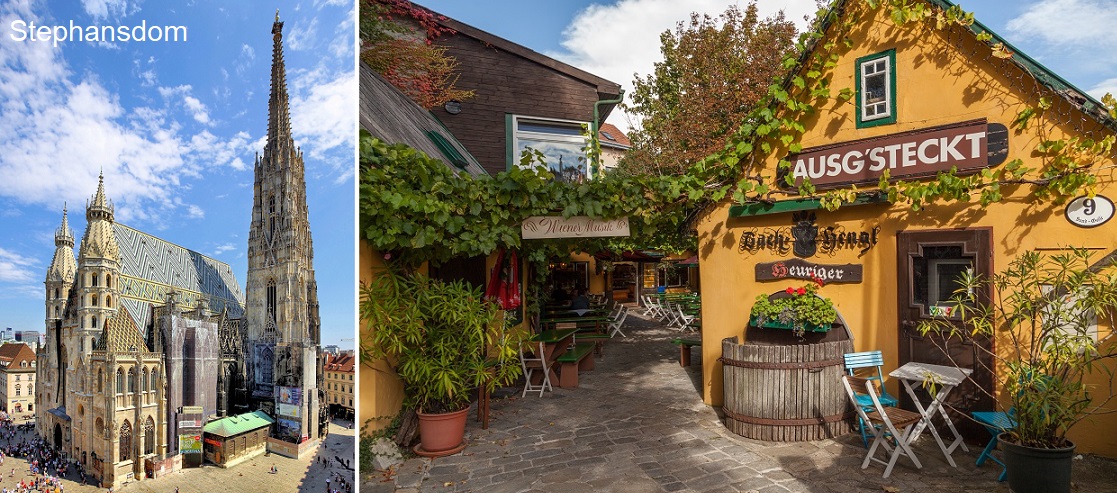
History of Viennese viticulture
Viennese viticulture has a two-and-a-half-thousand-year history and is at least as old as the city itself when it was still a small settlement. The Celts and before them the Illyrians had already practised viticulture in this area, which they called "Vedunia", in 500 BC, even before the Romans, as many finds such as wine barrels, pressing devices and grape seeds prove. Among others, also at the two vineyards Bisamberg and Nußberg, where many vineyards are still planted today. When Emperor Marcus Aurelius Probus (232-282) lifted the ban imposed by Emperor Domitian (51-96) on planting vines outside Italy, the legionaries in "Vindobona" began to cultivate vines and apply Roman methods. The picture below right shows the emperor instructing the Noric tribe (Noricum = Celtic kingdom) in viticulture. Today's large city with an area of over 400 km² is literally built on vineyards.
Even in the late Middle Ages, the largest parts of today's 23 Viennese municipal districts were full of many vineyards, also in today's core area of the city within the so-called "Gürtel", a main artery enclosing the municipal districts of Innere Stadt (1) to Alsergrund (9). There are documents attesting to vineyards in the present-day districts or boroughs of Stadtpark, Minoritenplatz, Rennweg, Alserbach, Alsegg, Matzleinsdorf, Linke Wienzeile, Weißgerberlände, Landstraße, Wieden and Mariahilf. Throughout the Middle Ages, winegrowing was one of the main sources of income in Vienna and many Viennese lived directly and indirectly from it. Even in the early Middle Ages the innkeeper's trade was considered a lucrative business and there is documentary evidence of wine tavern names from the 14th century. The picture on the left shows a vineyard on the Glacis in 1547, an open space in front of the city walls in front of the Löwelbastei (today roughly the square of the University of Vienna).
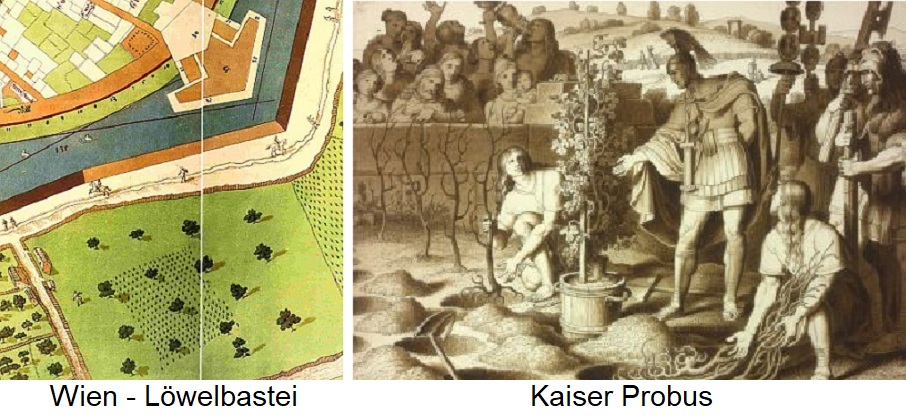
Today's "Stubenviertel" in the 1st district got its name from the many wine taverns and guest gardens in this area. There were regulations about who was allowed to serve and sell wine and under what conditions, with protective measures against carousers and rowdies. For "boozing and brawling" was also part of the Viennese way of life at that time. The epistle Sauffnarr by the famous preacher Abraham a Sancta Clara (1644-1709) provides eloquent information about this. Strict laws were passed to protect wine. Strong competition arose from beer, and Duke Albrecht V (1397-1439) banned the public serving of wine in 1430, saying that it might cause great harm to the town and our burghers who had wine wax.
From the middle of the 14th century, exports began to flourish and Viennese wine was sold to the Holy Roman Empire (Germany), Poland and Bohemia. At the beginning of the 15th century, vineyards in Vienna and the surrounding area grew rapidly and almost completely displaced arable farming. Therefore, in 1426 Duke Albrecht V forbade the planting of new vineyards in order to secure the city's food supply. Emperor Ferdinand I (1503-1564) designated wine as the first food of the city of Vienna in a city charter. The wine book by the clergyman Johann Rasch (1540-1612) describes in detail viticulture, wines, vineyard cultivation, cellar techniques and also drinking culture at this time.
Emperor Ferdinand III (1608-1657) used wine to finance the defence of Vienna against the siege of the Swedes during the Thirty Years' War (1618-1648) by introducing a wine tax of one groschen per stored bucket of wine in 1639. It was successful in repelling the Swedes. The captured Swedes were given a glass of the taxed wine, which was called "Swedish wine", as a mockery. The best wines were stored in the three-storey imperial and royal court cellar deep below the castle. Hofkeller deep under the castle. The then Emperor Leopold I (1640-1705) commissioned the construction of a giant barrel with a volume of 5,050 buckets, which was 285,000 litres of wine. A wine history of Vienna would be incomplete without mentioning the famous Bänkelsänger Lieber Augustin (lived in the 17th century). Worth reporting is the year 1443, when the wine was so extreme acid that allegedly even the tyres of the barrels were attacked. In the Viennese vernacular, which has always known how to "get to the heart of things", the term " Reifbeißer " was therefore created.
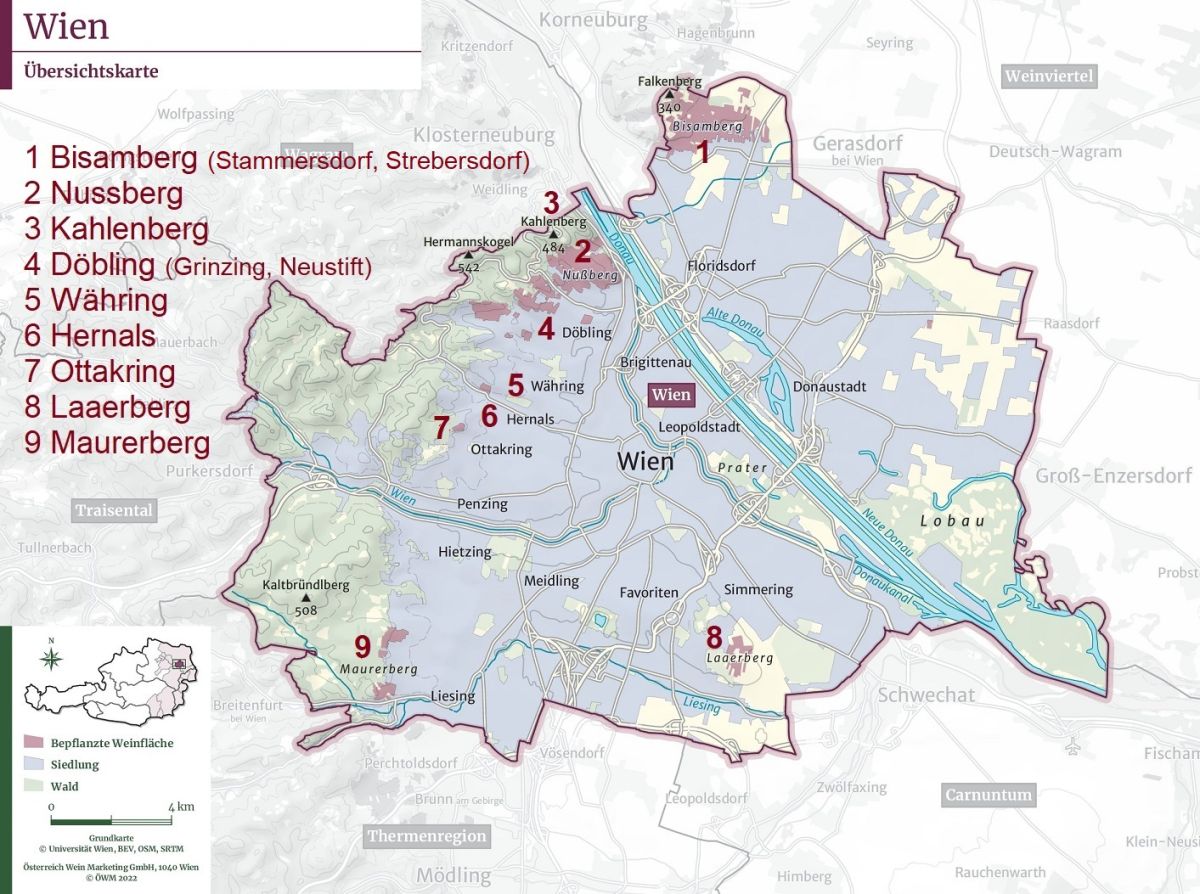
Viticulture in Vienna today
Vienna is both a generic and specific wine-growing region. Together with the provinces of Lower Austria and Burgenland, it forms the wine-growing region of Weinland. Around 500 winegrowers are engaged in viticulture, especially in the west and north of the city. There are vineyards in 9 of Vienna's 23 districts. The majority of the 145 vineyards are located in the 19th district of Döbling (86 with over 300 hectares), in the 21st district of Floridsdorf (33) and in the 23rd district of Liesing (11). There are five major vineyards (all of which are described in detail in their own keywords), as well as other vineyards. The major sites are:
- Bisamberg-Wien (1) - 21st Floridsdorf with cadastral communities Groß-Jedlersdorf, Stammersdorf, Strebersdorf
- Kahlenberg (3) - 19th Döbling with the cadastral communities Kahlenbergerdorf, Josefsdorf
- Laaerberg (8) - 10th Favoriten with cadastral commune Oberlaa Stadt
- Maurerberg (9) - until 2018 Georgenberg - 23. Liesing with cadastral communities Liesing, Mauer, Kalksburg, Rodaun
- Nußberg (2) - 19th Döbling with cadastral communities Nußdorf, Heiligenstadt
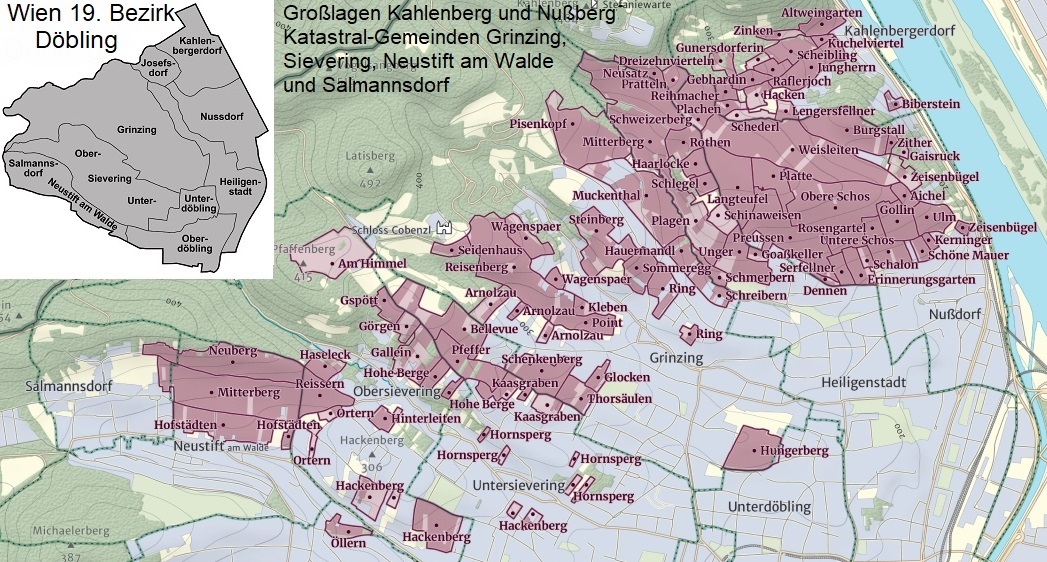
In addition, there are further vineyards in the districts, cadastral communities and Rieden:
- 01. Innere Stadt - Schwarzenbergplatz in the front garden of a Ringstrasse palace (see below).
- 13th Hietzing - Schönbrunn Palace with vineyards Gloriette and Liesenpfennig, Speising with vineyard Bergheiden
- 16. Ottakring (7) - Ottakring with vineyards Liebhart-Sommerleiten, Rosengartl, Wilhelminenberg
- 17. Hernals (6) - Dornbach with vineyards Alsegg, Heuberg
- 18. Währing (5) - Pötzleinsdorf with vineyard Öllern
- 19. döbling (4) - Grinzing, Neustift am Walde, Obersievering, Untersievering, Salmannsdorf
- 22. donaustadt - Breitenlee with Riede Stadlbreiten, Süßenbrunn with Riede Süßenbrunn
Possible indications of origin are Riede (e.g. Alsegg, Preußen, Reisenberg, Rosengartl), Großlage (e.g. Bisamberg, Nußberg), Katastralgemeinde (e.g. Grinzing, Neustift a. W., Stammersdorf) or Bezirk (e.g. Donaustadt, Hernals, Ottakring).
A provincial law that came into effect in 2015 now stipulates that Vienna's vineyards must be compulsorily cultivated; this puts them under monument protection, so to speak. All cultivators or property owners of Viennese vineyards are obliged to use them for viticultural purposes. Even areas that were cleared after the law came into force must be replanted after eight years at the latest. The winegrowers of the WienWein association had campaigned for this. In the past, Vienna's vineyards were always threatened by real estate speculation, because existing zoning and development plans offered too little protection. The law put an end to this.
Vineyards Schwarzenbergplatz and Schönbrunn Palace
A curiosity is the smallest vineyard in Vienna, with only 75 vines on about 170 m², in a front garden of the Ringstrasse-style palace "Wiener von Welten" at Schwarzenbergplatz 2 in the 1st district. It was planted around 1900 by a caretaker from Transylvania. Every autumn the first grapes are harvested by the Viennese mayor with media attention. The vinification is done by the Mayer winery on Pfarrplatz in the 19th district of Döbling. The harvest yields about 50 to 60 bottles of Wiener Gemischter Satz (with the main share of the variety Grüner Veltliner), which are then auctioned off in December on the occasion of the humanitarian campaign "Licht ins Dunkel". There is also a small vineyard called Liesenpfennig in the baroque garden of the world-famous former imperial residence Schönbrunn Palace.
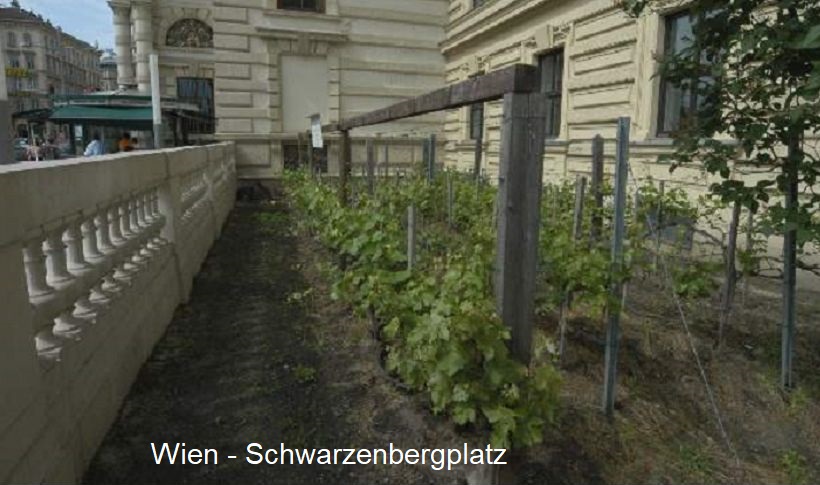
Vineyard list
In 2023, the vineyards covered a total of 582 hectares of vines. Compared to 2016 with 637 hectares, there was a reduction of 55 hectares (8.6%). The share of white wine varieties is 81% and red wine varieties 19%. The famous Wiener Gemischter Satz (white varieties) is in the lead, followed by Grüner Veltliner, Riesling and Zweigelt.
Grape variety
|
in Austria
|
Colour |
HA
|
%
|
HA
|
%
|
| Gemischter Satz | - | white | 228 | 39 | 179 | 28 |
| Grüner Veltliner | Weißgipfler | white | 94 | 16 | 137 | 21,5 |
| White Riesling | Riesling, Rhine Riesling | white | 46,2 | 7,9 | 60 | 9,4 |
| Zweigelt | Blue Zweigelt, Rotburger | red | 32,6 | 5,6 | 42 | 6,5 |
| White Burgundy | Pinot Blanc, Klevner | white | 26,3 | 4,5 | 43 | 6,7 |
| Chardonnay | Morillon - not used in Vienna | white | 24,5 | 4,2 | 30 | 74,6 |
| Pinot Noir, Pinot Noir | Pinot Noir, Pinot Noir, Pinot Noir | red | 19 | 3,3 | 19 | 2,9 |
| Merlot | red | 10,1 | 1,7 | 10 | 1,6 | |
| Welschriesling | - | white | 9,9 | 1,7 | 19 | 2,9 |
| Muscat Blanc | Yellow M., Red M. / Muscat Blanc | white | 8.8 | 1,5 | 10 | 1,5 |
| Sauvignon Blanc | Muscat Sylvaner | white | 8,2 | 1,4 | 11 | 1,8 |
| Cabernet Sauvignon | - | red | 7,2 | 1,2 | 9,2 | 1,4 |
| Müller-Thurgau | Rivaner | white | 6,3 | 1,1 | 12 | 1,8 |
| Blauburger | - | red | 5,7 | 1 | 8 | 1,2 |
| Traminer | Gewürztraminer, Red T., Yellow T. | white | 5,7 | 1 | 7 | 1,1 |
| St. Laurent | - | red | 5,4 | 0,9 | 8 | 1,3 |
| Blaufränkisch | - | red | 3,5 | 0,6 | 3,5 | 0,5 |
| Grey Burgundy | Pinot Gris, Ruländer | white | 3 | 0,5 | 4,5 | 0,7 |
| Blue Portugieser | - | red | 2,7 | 0,5 | 4,9 | 0,8 |
| Cabernet Franc | - | red | 2,6 | 0,5 | 1,0 | 0,2 |
| Neuburger | - | white | 2,4 | 0,4 | 5,5 | 0,9 |
| Roesler | red | 2 | 0,3 | 2 | 0,3 | |
| Frühroter Veltliner | - | white | 1,4 | 0,2 | 2,6 | 0,4 |
| Syrah | Shiraz | red | 1,3 | 0,2 | 0,8 | 0,1 |
| Bouvier | - | white | 1 | 0,2 | 1,6 | 0,3 |
| Roter Veltliner | - | white | 0,8 | 0,1 | 1,1 | 0,2 |
| Sylvaner | Green Sylvaner | white | 0,5 | 0,1 | 1,2 | 0,2 |
| Muscat Ottonel | - | white | 0,5 | 0,1 | 1,2 | 0,2 |
| Muscaris | - | white | 0,3 | - | - | - |
| Zierfandler | Late red | white | 0,2 | - | 0,6 | 0,1 |
| Rotgipfler | - | white | 0,2 | - | 0,4 | 0,1 |
| Furmint | - | white | 0,2 | - | - | - |
| Scheurebe | seedling 88 | white | 0,1 | - | 0,4 | 0,1 |
| Goldburger | - | white | 0,1 | - | 0,3 | - |
| Rathay | - | red | 0,1 | - | 0,1 | - |
| Souvignier Gris | - | white | 0,1 | - | - | - |
| remaining varieties | - | white/red | 16,3 | 2,8 | 3,4 | 0,5 |
WHITE SORT |
471 |
81 |
529 |
83 |
||
RED SORT |
111 |
19 |
108 |
17 |
||
TOTAL |
582 |
|
637 |
DAC System "Viennese Gemischter Satz
The typical Viennese Heurigen wine is the " Gemischter Satz", in which, according to an old tradition, different grape varieties are planted together in the vineyard and harvested and processed together. In 2009, the "Wiener Gemischte Satz" was accepted by the Slow Food Association as a "passenger" of the "Ark of Taste". It is thus one of the foods that should be strictly protected from the great threat posed by industrial agriculture and the food industry and preserved for future generations. The origin-controlled Wiener Gemischter Satz DAC has been available since the 2013 vintage.
In contrast to the other wine-growing regions, all Viennese quality wines may continue to be marketed as "Viennese wine" (non-DAC quality wines from the Weinviertel, for example, may only be marketed with the generic wine-growing region of Lower Austria as their origin). A Gemischter Satz, which does not comply with the above-mentioned provisions, must be marketed as a Landwein with the designation of origin Weinland.
Producers
Well-known Viennese wine producers who often also have a wine tavern attached are Bernreiter Peter, Christ Rainer, Cobenzl, Edlmoser Michael, Fuhrgassl-Huber, Göbel Hans-Peter, Hajszan-Neumann, Helm Robert, Hengl-Haselbrunner, Hofer Wolfgang, Kattus, Langes Irene, Lentner Karl, Mayer am Pfarrplatz, Mayer Vitikultur, Nössing Manuel, Pfaffl Roman, Reinprecht Hugo, Rotes Haus, Schilling Herbert, Stift Klosterneuburg, Wieninger, Winzerhof Leopold and Zahel. Well-known winegrowers' associations are Traditionsweingüter Österreich, Vienna Classic and WienWein.
St. Stephen's Cathedral: By Bwag - Own work, CC BY-SA 4.0, Link
Heuriger: By Otto Domes - Own work, CC BY-SA 4.0, Link
Weingarten Glacis and Probus: History Vienna WIKI
Maps Vienna and Döbling: © ÖWM - edited by Norbert F. J. Tischelmayer
Schwarzenbergplatz: By GuentherZ - Own work, CC BY-SA 3.0, Link
Classified wine producers in Vienna 9
find+buy for Vienna 19
Recent wines 444
 Weingut Nössing
— Vienna
2015 Bisamberg trocken Cuvée
88 WP
very good
28.00 €
Weingut Nössing
— Vienna
2015 Bisamberg trocken Cuvée
88 WP
very good
28.00 €

 Weingut Nössing
— Vienna
2022 Wiener Gemischter Satz DAC trocken
87 WP
very good
11.00 €
Weingut Nössing
— Vienna
2022 Wiener Gemischter Satz DAC trocken
87 WP
very good
11.00 €

The most important grape varieties
More information in the magazine
- Where wine was once used as a building material Wine-growing regions in Austria: Vienna
- In Focus: Grüner Veltliner The elegant ones are coming
- How the Viennese Waltz became world famous with champagne Ron Merlino on Johann Strauss and the good business of wine and music
- "People have not changed!" Vienna's top sommeliers Simon Schubert and Thomas Reither on wine sales in their star restaurants after Corona
- Heavy bottle, golden label and high ratings Export manager Paul Kiefer on problems and success in China
- Austria In Focus Vienna and Carnuntum
- Vienna Much more than just Heurigen culture
- Focus on Austria Part 1: Weinviertel and Vienna
- From cellar to cult A Viennese exhibition celebrates the new Austrian wine architecture
- "We winegrowers need legal certainty in uncertain times" Interview: Alois Höllerer, "Happy Situation" initiative

